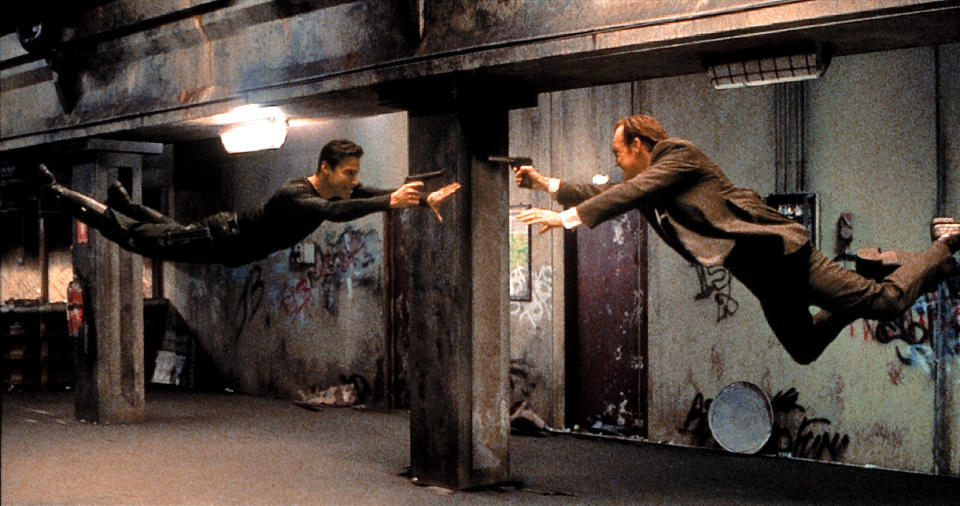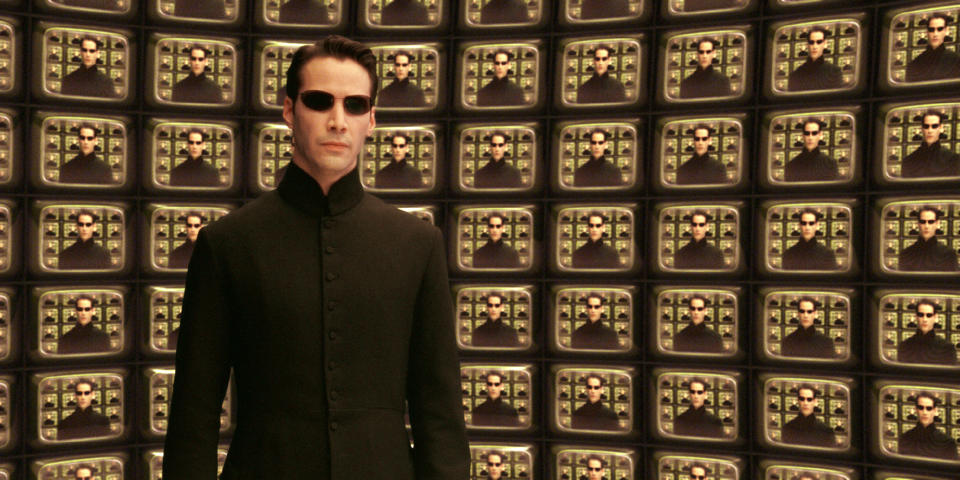'The Matrix' at 20: 5 things you didn't know about the sci-fi classic
On March 31, 1999, moviegoers chose the red pill and woke up in the world of The Matrix. Flash-forward 20 years, and Lana and Lily Wachowski’s sci-fi classic remains a mind-bending fusion of Hollywood special effects magic and Far East philosophy. A labor of love for the Chicago-born siblings, The Matrix tells the story of seemingly ordinary hacker, Thomas Anderson, aka Neo (Keanu Reeves), who learns that he’s part of a much bigger world. Make that two worlds: our post-apocalyptic reality and the digital realm name-checked in the title.
As Neo’s mentor, Morpheus (Laurence Fishburne) is fond of saying: “No one can be told what the Matrix is. You have to see it for yourself.” The same goes for some of the secrets behind the movie. With that mind, we’re going to tell — and show — you five things you may not have known about The Matrix. Buckle your seatbelt, because Kansas is going bye-bye. (Watch our video above.)
Will Smith and Val Kilmer were the original choices for Neo and Morpheus
Over on his popular YouTube page, the Fresh Prince recently confirmed a longstanding piece of Matrix mythology: he did turn down the role of Neo. As Smith explains, the offer came his way in the late ’90s, after he made the back-to-back sci-fi hits, Independence Day and Men in Black. Not wanting to be pigeonholed as the “alien movie guy,” the actor was already skeptical about entering The Matrix. And it didn’t help that the Wachowskis’ pitch game wasn’t particularly strong. In the video, Smith suggests that the siblings had a hard time explaining how they’d accomplish the incredible effects described on the page. “‘So, dude, we’re thinking like, imagine, you’re in a fight and you, like, jump. Imagine if you could stop jumping in the middle of the jump.'”
Smith also mentions that, had he said yes to the film, Val Kilmer would likely have played Morpheus instead of Laurence Fishburne. “If I had done it, because I’m black, than Morpheus wouldn’t have been black,” he says. “So I probably would have messed The Matrix up! I would have ruined it. So I did y’all a favor.” It’s not like Smith and Kilmer had trouble finding work after turning down the Wachowskis. In fact, both actors had major motion pictures released in 1999: Kilmer played a blind man in the romantic drama At First Sight, while Smith starred in the would-be summer blockbuster Wild Wild West. It’s goes without saying that neither of those movies left the same kind of pop culture imprint as The Matrix.

For the record, Smith wasn’t the only actor in consideration for Neo. According to Matrix producer, Lorenzo di Bonaventura, other candidates included Leonardo DiCaprio, Brad Pitt and Reeves’s Speed co-star Sandra Bullock.
Bullet time broke special-effects barriers
Once he frees his mind, Neo makes dodging bullets look easy when he’s inside the Matrix. But in the real world the movie’s signature “bullet time” effect took years of research, hundreds of cameras and months of intensive post-production work. F/X wizard, John Gaeta, took point on cracking how to make the Wachowskis’ dream become a reality, eventually devising a mixed media approach that incorporated still photography and computer-generated environments. .
For every “bullet time” sequence, Gaeta and his team would recreate an actual set inside of a computer. The actors would then be filmed against a green screen, their movements captured by a configuration of still cameras and motion-picture cameras. That information was then transferred into a computer program where they could manipulate the frame count and speed of each shot. The subway confrontation between Neo and Agent Smith (Hugo Weaving) alone required 120 still cameras, plus two additional motion-picture cameras.
Fortunately, all that hard work paid off handsomely: the movie’s visual-effects crew won an Oscar, beating out Star Wars: Episode I: The Phantom Menace and Stuart Little. In fact, The Matrix made a clean sweep of its four nominations, also winning for Best Film Editing, Best Sound and Best Sound Effects Editing.
Keanu’s plunge was inspired by Wile E. Coyote’s cliff dive
Sometimes you’ve got to fall before you can fly. That’s what happens to Neo the first time he tries to follow Morpheus’s lead and leap between tall buildings in a single bound. Instead, he winds up plummeting to the bottom of an urban canyon, making the crew of the Nebuchadnezzar question whether he really is “The One” that their boss has prophesied.
The Wachowskis modeled this moment of abject failure after the catastrophe-prone Looney Tunes character Wile E. Coyote. Generations of children have laughed as this poor canis latrans has repeatedly failed in his pursuit of a tasty Road Runner snack — a chase that, more often than not, ends with him swan diving off of a cliff. Hey, if you’ve got to eat pavement, learn from the master. Meep-meep.
The agent-spotting program is full of twins
In order to teach Neo how to tell a Matrix Agent apart from a Matrix civilian, Morpheus fires up an Agent-spotting training program. This simulation recreates a busy Chicago street, where their suite-and-tie wearing nemeses are hidden amongst ordinary passers-by. But if you slow this scene down, you’ll realize that those passers-by aren’t so ordinary. Upon closer inspection, the frame is filled with a lot of the same faces.
That’s because the Wachowskis populated this sequence with multiple sets of real-life twins, many of whom appear on camera more than once. As explained on one of the commentary tracks included on The Matrix Blu-ray release, the motivating idea behind this casting choice was that whoever wrote the training program got lazy at a certain point and just started recycling the same faces over and over. Not for nothing, but seeing so many clones is also a reminder that there’s only one Neo.

Enter the Architect
You may not like where the supremely underrated Matrix sequels — 2003’s Reloaded and Revolutions — take Neo’s story … you can’t say the Wachowskis didn’t prepare you. In the famous interrogation room sequence from the original film, we see Neo on a bank of TV monitors as awaits Agent Smith’s entrance. You might think that other Agents are watching those TV screens, but Neo is actually being monitored by his creator, The Architect.
That’s confirmed at the end of The Matrix Reloaded, when the two come face-to-face, and Neo learns some uncomfortable truths about the actual function of The One. The Architect’s lair turns out to be a large room filled with TV screens broadcasting scenes from Neo’s life, including his interrogation room encounter. As Neo would say … “Woah.”
The Matrix Trilogy is available on 4K Ultra HD and Blu-ray on Amazon, Barnes & Noble, Target and Walmart. The individual movies can also be streamed on Amazon Prime.
Read more from Yahoo Entertainment
Disney goes dark: The Mouse House’s 8 scariest movie moments — and why they might be good for you
The ‘Forrest Gump’ sequel that never was, from O.J. to Oklahoma City
‘The Little Mermaid’ turns 30: Jodi Benson on bringing Ariel to life
Want daily pop culture news delivered to your inbox? Sign up here for Yahoo Entertainment & Lifestyle’s newsletter.


